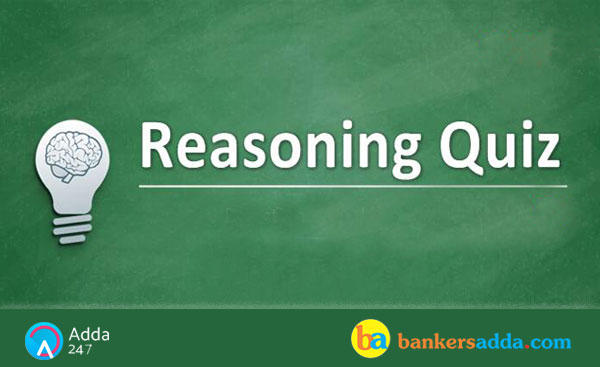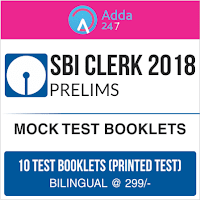Dear Aspirants,
Reasoning Ability is an onerous section. With the increasing complexity of questions, it becomes hard for one to give it the cold shoulder. The only way to make the grade in this particular section in the forthcoming banking exams is to practice continuously with all your heart and soul. And, to let you practice with the best of the latest pattern questions, here is the Adda247 Reasoning Quiz based on the exact same pattern of questions that are being asked in the exams.
Directions (1-5): Study the following information and answer the questions given below:
There are seven friends namely A, B, C, D, E, F and G. All of them go for a movie in a week starting from Monday to Sunday (of the same week) but not necessarily in the same order. Only one person goes for a movie on each day.
A goes for a movie before Thursday. Three friends go for a movie between the days on which A and F goes. Two friends go for a movie between F and B. Only one friend goes for a movie between B and G. Only one friend goes for a movie between D and G. Two friends go for a movie between D and C. E does not go for a movie on Sunday.
Q1. Who among the following goes for a movie on Sunday?
(a) E
(b) C
(c) D
(d) G
(e) F
Q2. Four of the following five are alike in a certain way and so form a group. Which of the following does not belong to that group?
(a)F-Sunday
(b)E-Tuesday
( c) D-Saturday
(d)C-Friday
(e)B-Thursday
Q3. Who among following goes for a movie immediately before the days on which C goes for a movie?
(a) E
(b) A
(c) D
(d) B
(e) F
Q4. F goes for a movie on which of the following days?
(a) Friday
(b) Saturday
(c) Monday
(d) Wednesday
(e)Tuesday
Q5. A goes for a movie on which of the following day?
(a) Friday
(b) Saturday
(c) Monday
(d) Wednesday
(e)Tuesday
Directions (6-9): In each of the questions below is given two statements followed by two conclusions numbered I and II. You have to take the given statements to be true even if they seem to be at variance with commonly known facts. Read all the conclusions and then decide which of the given conclusions logically follows from the given statements disregarding commonly known facts.
Q6.Statements:
All light is sun.
All sun is moon.
Conclusions:
I. Some moon being light is a possibility.
II. All sun being light is a possibility.
(a) None follows
(b) Only I follows
(c) Only II follows
(d) Either I or II follow
(e) Both I and II follow
Q7.Statements:
Some exam is result.
No result is paper.
Conclusions:
I. Some exam is not paper.
II. All paper being exam is a possibility.
(a) None follows
(b) Only I follows
(c) Only II follows
(d) Either I or II follow
(e) Both I and II follow
Q8.Statements:
All cup is tea.
No tea is milk.
Conclusions:
I. All cup being tea is a possibility.
II. No cup is milk.
(a) None follows
(b) Only I follows
(c) Only II follows
(d) Either I or II follow
(e) Both I and II follow
Q9.Statements:
Some sony is dell.
All dell is nokia.
Conclusions:
I. Some nokia is not sony.
II. All dell being sony is not a possibility.
(a) None follows
(b) Only I follows
(c) Only II follows
(d) Either I or II follow
(e) Both I and II follow
Directions (10-12): Study the information and answer the following questions:
In a certain code language
‘sun like the bright’ is written as ‘sx vt mp zq ’,
‘star bright always good’ is written as ‘ mp cv bx yt ’,
‘the good thing star’ is written as ‘ zq yt fa cv’,
Q10. What is the code for ‘always’ in the given code language?
(a) mp
(b) cv
(c) bx
(d) yt
(e) None of these
Q11. What is the code for ‘bright’ in the given code language?
(a) vt
(b) sx
(c) mp
(d) zq
(e) None of these
Q12. What is the code for ‘star’ in the given code language?
(a) zq
(b) yt
(c) fa
(d) Cannot determined
(e) cv
Directions (13-15): In these questions, relationship between different elements is shown in the
statements. These statements are followed by two conclusions:
(a) If only conclusion I follows.
(b) If only conclusion II follows.
(c) If either conclusion I or II follows.
(d) If neither conclusion I nor II follows.
(e) If both conclusion I and II follow.
Q13. Statements: P < Q = R ≤ S > T < U
Conclusion:
I. P>U
II. U
Q14. Statements: A ≥ B = C > D ≥ E > F
Conclusion:
I. A>E
II. C >F
Q15. Statement: J = K ≥ L < M = N ≤ O
Conclusions:
I. K> O
II. O>L
You May also like to Read:
- More questions on Reasoning for Bank exam
- Reasoning ability study notes and tips
- SBI Clerk Mock Tests 2018







